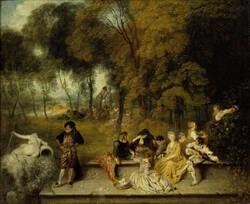A group of elegantly dressed courtly figures sits on a stone wall in parkland, chatting and listening to a musician play. On the left, a bachelor in luxurious garments contemplates a fountain sculpture of a naked nymph, thus enhancing the frivolous, relaxed mood of the painting. This image belongs to the category of “fêtes galantes” (‘courtship parties’), which enjoyed great popularity in France in the early 18th century and were invented by Watteau.
Further Media
The parkland setting may look very natural, yet at the same time, the scenery has something exceptionally artificial. Don’t the figures in the foreground seem rather like actors on the stage? Couldn’t the distant landscape be just a theatre backdrop? It is not exactly clear where reality stops and the game of courtship begins. Here, quite possibly, we are not looking at a real event, but a stage performance.
There is undoubtedly a connection to the theatre, since the genre of the fête galante was heavily influenced by the traditional form of improvised theatre in Italy – the commedia dell’arte. The commedia dell’arte figures and costumes were exceptionally popular in eighteenth-century Paris.
The colourful ambiguity is, in any case, a main feature of rococo art, a stylistic era roughly between 1710 and 1770.
- Location & Dating
- c. 1718/19
- Material & Technique
- Oil on canvas
- Dimenions
- 60 x 75 cm
- Museum
- Gemäldegalerie Alte Meister
- Inventory number
- Gal.-Nr. 781

